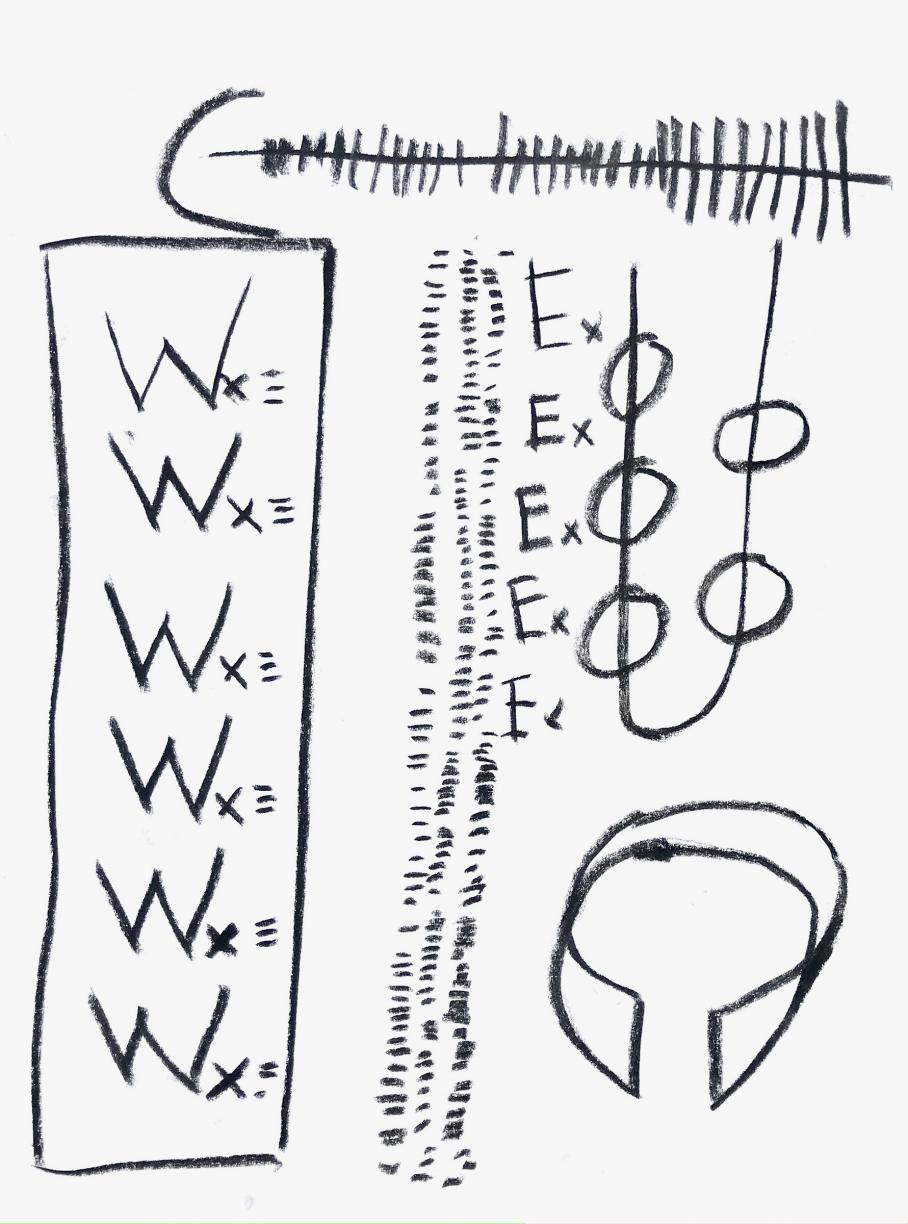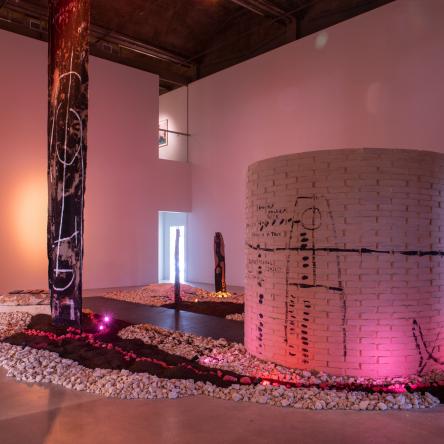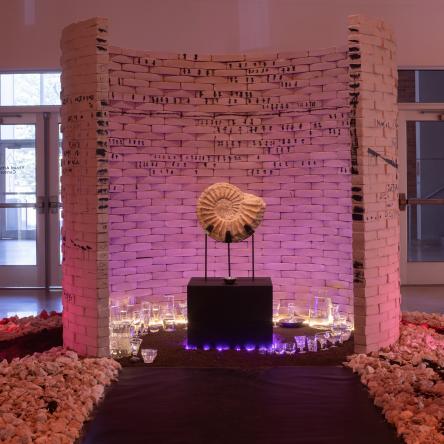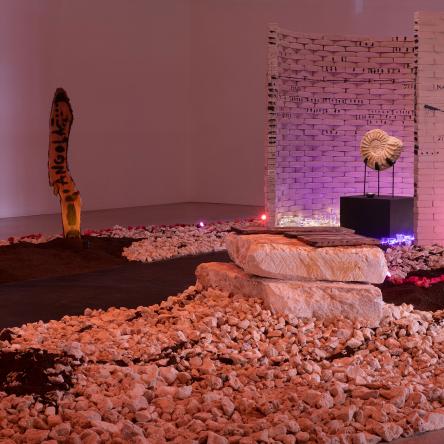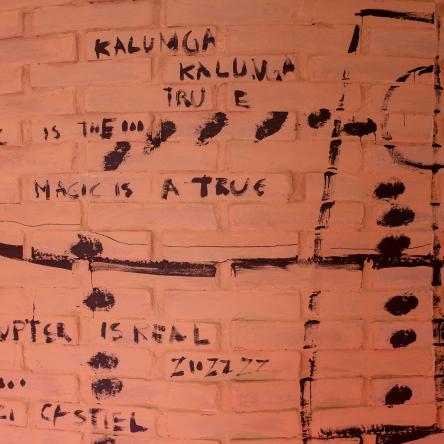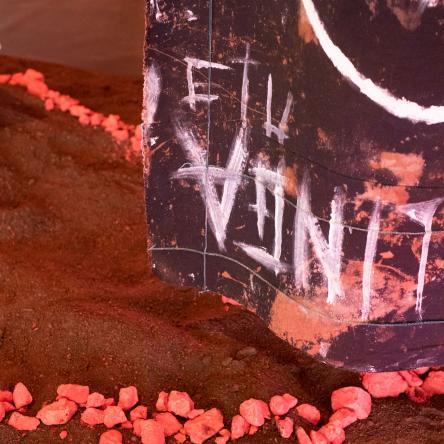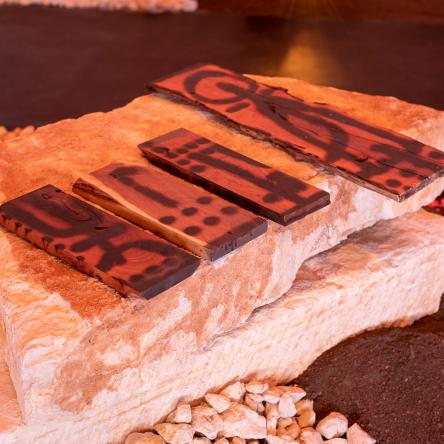Freedom brought me here. And the feeling of being alien on my own planet also made me create this project.
What is happening in these other zones that coloniality calls the “other world?” This is not an anthropological question, but one of faith.
I believe there are other ways of living. And this installation is a piece of my world, of the planet from which I came.
A perishable space of freedom. To create it, I used the so-called pontos riscados de Umbanda, as architectural lines.
I also studied the aquatic history of Texas, which at one time was a sea.
I believe in Kalunga as the liquid power of transmutation, and therefore am thrilled to have the fossil of an ancestral marine animal in this project.
I believe in water as a spiritual element, as an energy conductor, capable of cleaning and nourishing, so I created this great path unfolding toward its contemplation.
This work is a space to linger, sit, lay down, and look with respect, care, intuition, and love.
Jupiter is a relative condition. When we observe life beyond this planet, Jupiter is only a word, just as the term “other” also is.
Jupiter can be here, on this planet. Because everything is celestial, cosmic. Everything is in everything.
* The pontos riscados de Umbanda are complex communication systems of Bantu origin, located on the border between words and drawings. They are signs that tell the story of the soul.
—
Jupiter is Here. Celestial is Everything is presented in conjunction with Social Fabric: Art and Activism in Contemporary Brazil, which is organized by Adele Nelson, Assistant Professor, Art History, UT Austin, and MacKenzie Stevens, Director, Visual Arts Center, with María Emilia Fernández, Assistant Curator.
Special thanks to the Jackson School of Geosciences Non-vertebrate Paleontology Laboratory, Just Trees, Ty Kasey and UT Landscape Services, Native Earth Block, and the University Co-op Materials Lab in the School of Architecture.
The Artist-in-Residence Program at the Visual Arts Center (VAC) is supported by the VAC Artist-in-Residence Endowed Fund.
Júpiter es aquí. Celestial es todo.
La libertad me trajo hasta aquí. Y esa sensación de ser alienígena en mi propio planeta también me hizo crear este proyecto.
¿Qué sucede en esas otras zonas que la colonialidad llama “otro mundo”? No se trata de una cuestión antropológica, sino de una cuestión de fe.
Creo que sí, hay otras formas de vivir. Y esta instalación es un pedazo de mi mundo, de mi planeta, de donde yo vine.
Un espacio perecedero de libertad. Para construirlo, utilicé los llamados pontos riscados de Umbanda como líneas arquitectónicas.
También estudié la historia acuática de Texas, que en algún momento fue un mar. Creo en Kalunga como ese poder líquido de transmutación, así que estoy muy emocionada por tener un fósil de un animal marino ancestral dentro de mi proyecto. Creo en el agua como un elemento espiritual, conductor de energía, capaz de limpiar y nutrir, por eso creé este gran camino hacia su contemplación.
Esta obra es un espacio en el cual permanecer, sentarse, acostarse y mirar, con respeto, cuidado, intuición y amor.
Júpiter es una condición relativa. Cuando observamos la vida fuera de este planeta, Júpiter es solo una palabra, así como “el otro” es sólo un término.
Júpiter podría ser aquí, este planeta. Porque todo es celestial, cósmico. El todo está en todo.
* Los pontos riscados de Umbanda son complejos sistemas de comunicación de origen bantú situados en la frontera entre la palabra y el dibujo. Son signos que cuentan la historia del alma
Bio
Castiel Vitorino Brasileiro (b. 1996, Vitória, Brazil) lives and works in planet Earth. She earned her BA in Psychology at Universidade Federal do Espíritu Santo (2019) and a MA in Clinical Psychology at Pontifíca Universidade Católica de São Paulo (2021). She has had solo exhibitions at the Hessel Museum of Art, Bard College, New York (2021) and Galeria Homero Massena, Vitória (2019). Her work has also been included in group exhibitions at the Pinacoteca do Estado de São Paulo (2022); Museo de Arte Contemporáneo de Panamá (2022); Museu de Arte Moderna do Rio de Janeiro (2021); Museu de Arte do Rio, Rio de Janeiro (2021); LUX, London (2021); Kunsthalle Wien, Vienna (2021); Centro Cultural São Paulo (2020/21); Frestas – Trienal de Artes, Sorocaba (2020/21); Centro Municipal de Arte Hélio Oiticica, Rio de Janeiro (2019); and Museu Capixaba do Negro, Vitória (2019); among others. She is a recipient of the PIPA Prize (2021) and ZUM/Instituto Moreira Salles Photography Grant (2021). She was in residence at La Becque, Lausanne in 2022, and at Museu de Arte Moderna do Rio de Janeiro in 2021 and the studio of Rosana Paulino in 2018.






